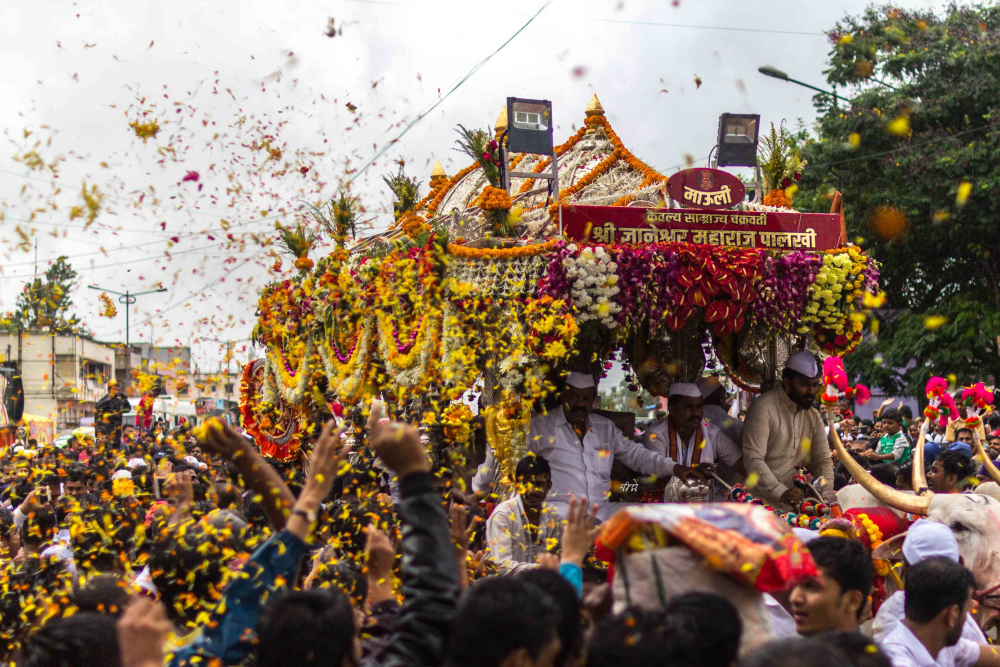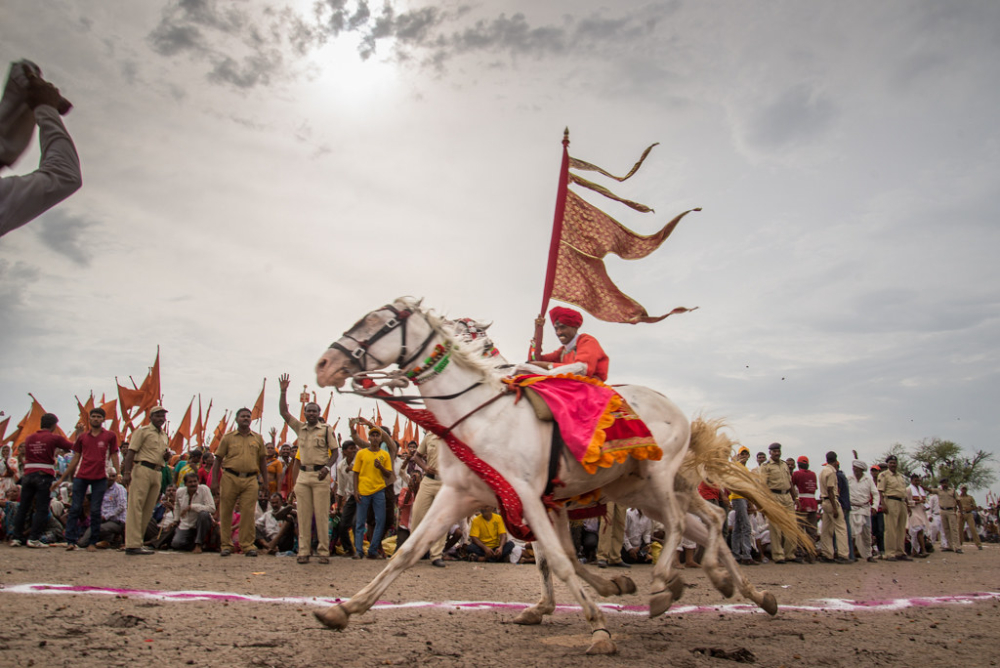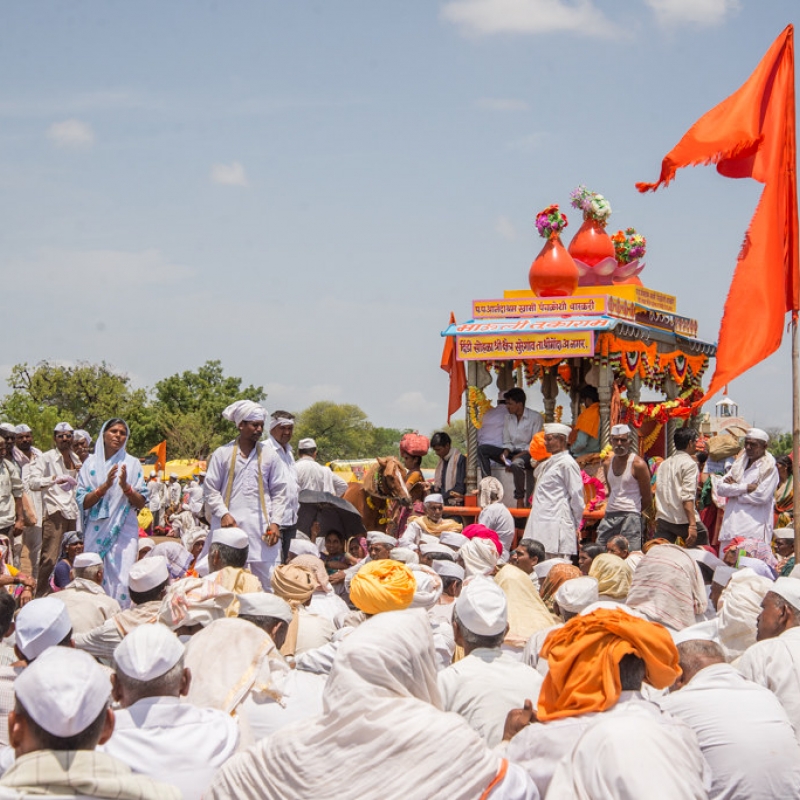The Pandharpur wari is a 21-day pilgrimage procession from various parts of Maharashtra to Pandharpur, the abode of Lord Vitthal. While the wari culminates on Ashadi Ekadashi, the revelry continues on till Guru Purnima. Attracting lakhs of devotees each year, we give an overview of this 800-year-old tradition. (Photo courtesy: Saurabh Chatterjee/Flickr)
If one has not been a part of the Pandharpur wari[1] before, nothing can prepare them for the sheer jolt to their senses as they approach and catch up with the pilgrimage procession. Countless saffron flags fluttering in the air; men with their colourful turbans and white Gandhi caps, veena, mridangam or other instruments in hand; women with pots of water or tulsi plants balanced on their heads; truck horns blaring on one side of the road and loud melodious chanting of the pilgrims on the other. All one can do in the beginning is to stand by and watch as the procession, like a mighty river, carries on.
The wari pilgrimage is the defining ritual of the Warkari panth (a Maharashtrian Vaishnava religious tradition), and Pandharpur, considered the abode of Vitthal,[2] has been at the center of this tradition. Even though the wari is undertaken four times a year, in the Hindu months of Chaitra, Magh, Ashadh and Kartik, it is the Ashadh pilgrimage that has come to be the largest and the most prominent one. The Ashadhi wari, as it is known, originates typically at the samadhis (commemorative shrines) of the many sant-kavis (saint-poets) of the panth and culminates in the temple-town of Pandharpur, on the auspicious day of the Ashadhi Ekadashi (eleventh day of the bright fortnight of Ashadh). The journey, which spans three weeks on average and is traditionally undertaken entirely on foot, is a way for the Warkaris to affirm their faith and commemorate their saint-poets. The term Warkari, in fact, literally translates to ‘those who do the wari’ and is often used to address every devotee who undertakes this pilgrimage whether or not they formally subscribe to the panth.
Also read | Kachargarh Pilgrimage of the Gond Adivasis
This year, in the wake of the COVID crisis, this longstanding tradition has come to a halt. Instead of as a part of the usual large procession, the palkhis (palanquins) of the various sant-kavis will be taken to Pandharpur in a special vehicle accompanied by only a few attendants. The situation, however, is not unprecedented. Records show that the wari had to be curtailed a few times in the past as well, such as in 1944–45, perhaps on account of World War II.
Two Prominent Palkhis
The wari pilgrimage usually comprises not one but several large and small processions dedicated to specific sant-kavis. The oldest, largest and most prominent ones are those dedicated to Dyaneshwar and Tukaram. The former was a thirteenth-century saint who laid the foundation of the panth by writing the Dyaneshwari, a Marathi commentary on the Bhagawad Gita, which has become the core text of the Warkaris. The latter lived in the seventeenth century, wrote numerous abhangas (devotional poems) for Vitthal and strongly advocated the use of bhajans and kirtans in the practice of bhakti. It was also Tukaram who started the tradition of carrying the padukas (sandals) of one’s revered saint to Pandharpur.
Haibatrao Baba Arphalkar, a rich nobleman from the Satara district, brought about other major changes to the wari in the early nineteenth century. A former soldier, he organised the pilgrimage to resemble a military procession, with fixed timetables and royal accouterments. He also started the practice of placing the padukas in attractively decorated palkhis to be carried on a chariot. While there are several views on how and why the Warkari pilgrimage to Pandharpur originated, it’s thought to be at least seven–eight centuries old. However, specific processions dedicated to the sant-kavis are relatively new, and the wari took on its present shape only after the innovations of Haibatrao Baba. Several ceremonies are performed along the way on the wari, such as the popular ringan, a race between two horses, one of which is left without a rider. At the end, it is this horse that customarily wins the race for it is believed to be ridden by the saint himself.
Also read | How Thai Pusam and Lord Murugan Form the Hallmark of Tamil Identity
Apart from the palkhis of Dyaneshwar and Tukaram, several others have joined the wari over the years. The number of pilgrims in each such procession is only growing, being anywhere from a few hundred to a few lakh.

The Deity in Pandharpur
Vitthal is the patron deity of the Warkaris, who waits for them at the end of their long and arduous journey. The Vitthal-Rukmini temple in Pandharpur houses a black idol of the deity, which stands on a raised platform resembling a brick, with arms akimbo. Believed to be a form of Vishnu-Krishna, it is said that a legendary sage named Pundalik brought Vitthal to Pandharpur. He impressed the deity so much with his devotion towards his parents that Vitthal was compelled to appear in person to grant him darshan. However, so busy was Pundalik in fulfilling his filial duties, that he made even Vitthal wait by asking him to stand on a vit (Marathi for ‘brick’), which gave the deity his unique name and peculiar stance.
Tukaram pretends to be upset with Pundalik for such a display of audacity, and in one of his poems he asks:
‘Hey Pundya! Why are you so proud
As to make Vitthal stand there?
Why are you so bold
As to toss a brick to him?…’[3]

An Annual Festival of Joy
It is telling that the Marathi word that is often used in relation to the wari is sohla, which connotes festival or celebration. For, more than a pilgrimage or a tirth yatra, the wari does play out as a huge festival, where everything—from the palkhi, the chariot, the veenas and tulsi plants carried by the Warkaris, and the images of Vitthal and Rukmini—is adorned to the hilt with flowers and finery. The multiple venues where the palkhi stops on its way to Pandharpur are elaborately decorated, and fairs often come up at such spots as locals throng for the palkhi’s darshan.
Most Warkaris themselves, coming as they do from rural agrarian backgrounds, are dressed in simple and unostentatious garb. Those who can afford to do so, pool in their resources to travel in a group. Many depend on benefactors for their meals and other needs, often sleeping outdoors when dharamshalas (religious rest houses) are full. Neither rain nor lack of means can dampen the zeal of the Warkaris, who are always ready to swing to the beats of the mridangam or spin in abandonment during a game of fugdi holding on to the hands of their fellow pilgrims.
This article was also published on Scroll.in.
Notes
[1] Wari derives from 'vaar', which, like the Hindi 'baar', refers to the frequency of an occurrence. So 'vari' refers to the regular practice of pilgrimage, the annual going and coming from the sacred place.
[2] Vithoba, also known as Vitthala, Vithu Mauli and Panduranga, is a Hindu deity predominantly worshipped among Maharashtrians. He is generally considered as a manifestation of Vishnu or his avatar, Sri Krishna. Vithoba is often depicted as a dark young boy, standing arms akimbo on a brick, sometimes accompanied by his main consort, Rakhumai.
[3] R.C. Dhere, The Rise of a Folk God: Vitthal of Pandharpur (New York: Oxford University Press), 28.













